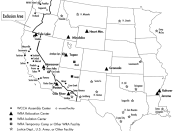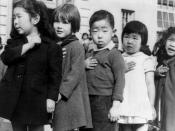Japanese American Internment Camps.
Like all issues involving race or war, the question of whether or not it was legal and ethical to make Japanese Americans move to relocation camps in early WWII is a difficult and controversial problem. The internment of around 50,000 Japanese citizens and approximately 70,000 Japanese-American people born in the U.S. living in the American West Coast has become known as a tragedy and mistake. The government even set up numerous projects to apologize to the American citizens who were wronged (Bosworth). Still, at the time that the decision to relocate was made, the actions were constitutionally legal and seen by many as necessary. The actions were not based on racist feelings. It was, however, unethical to put so many innocent people through frustration, suffering, and loss of not only their property but also their freedom. The bombing of the U.S. naval base in Pearl Harbor, Hawaii on December 7, 1941 by the Japanese marked the start of trouble for the 120,000 People of Japanese ancestry living in Oregon, Washington, California, and Arizona.
Because of their different language, culture, communities, customs, and religion, the Japanese living in America were already alienated from much of society (Brimner). Whites already had the fear of the "Yellow Peril" in their history, because of the prior Chinese immigration that had caused Caucasians to fear the loss of jobs to outsiders, among other things (Alonso, 14). When the bombing occurred, the people were so afraid of attack and the enemy that they feared Japanese living near the West Coast, (which was hard to defend and close to Japan,) so much that they turned to protests, discrimination and violent hatred (Alonso).
The Government, including President Franklin Delano Roosevelt, were pressured by the restlessness of the people, the threat of Japan's attack,


